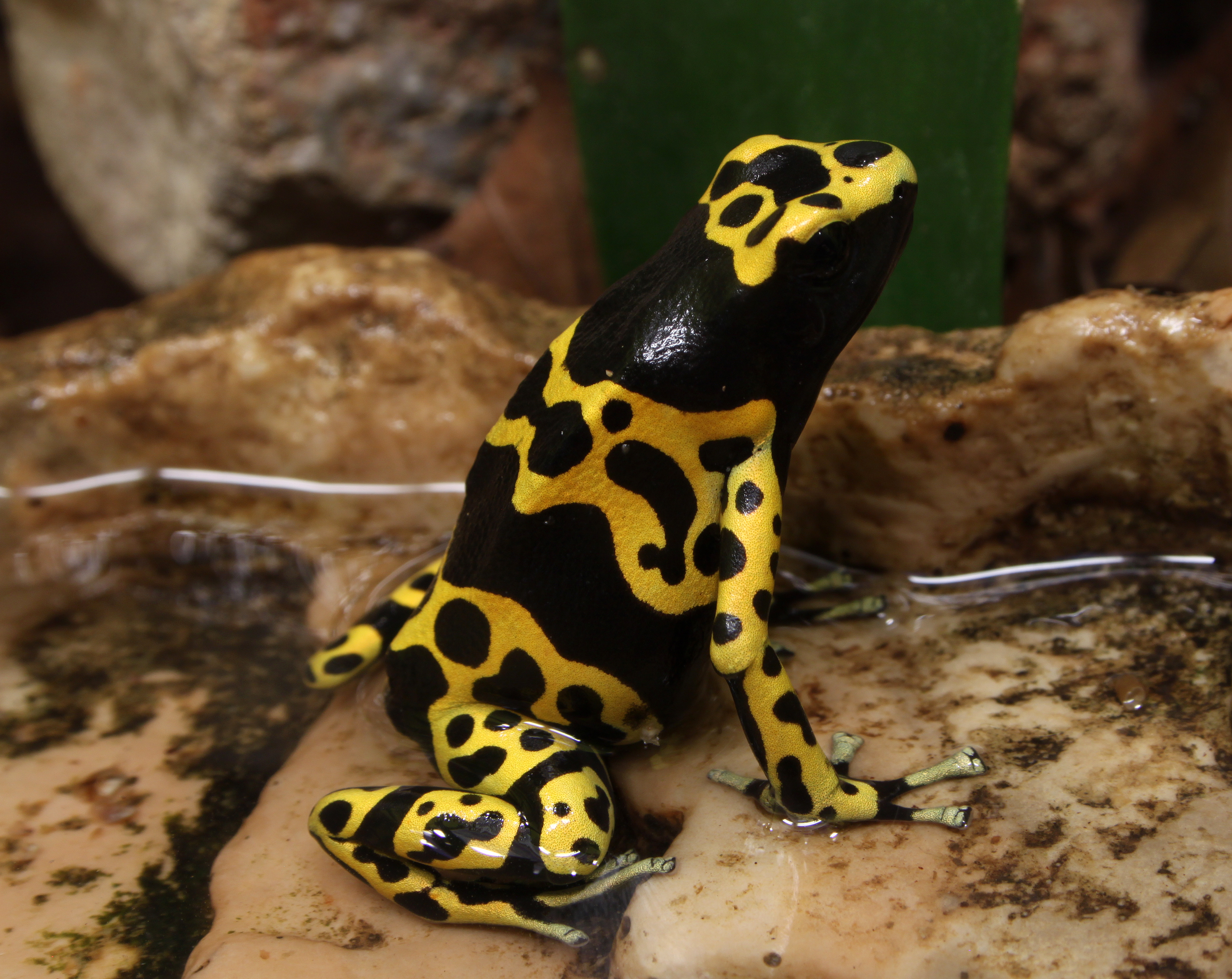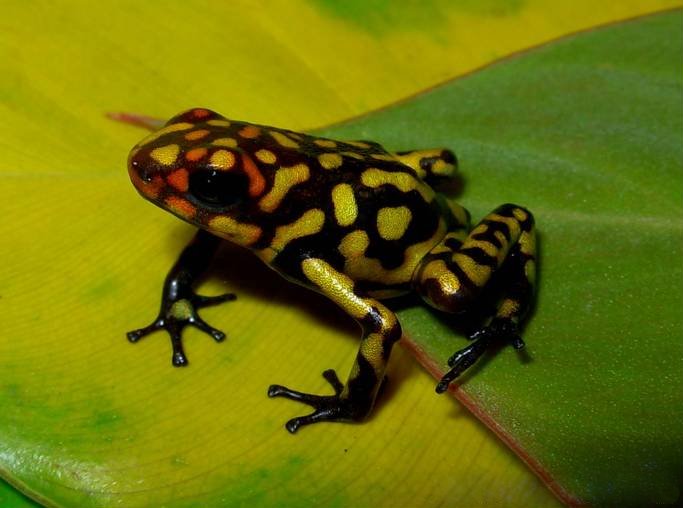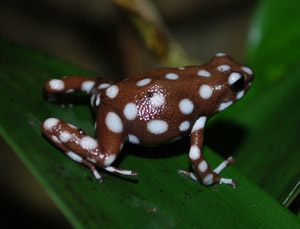|
Adelphobates
''Adelphobates'' is a small genus of poison dart frogs. They are found in the central and lower Amazon basin of Peru and Brazil, possibly Bolivia. It was originally erected as a sister group to the '' Dendrobates'' and '' Oophaga'' genera. The validity of the genus is still being discussed, with the alternative being "''Dendrobates galactonotus'' group" within '' Dendrobates''. One species originally placed in this genus as '' Adelphobates captivus'' has since been moved to the genus '' Excidobates'' erected in 2008. Etymology ''Adelphobates'' is from the Ancient Greek, ''adelphos'' (brother or twin) and ''bates'' (walker or climber)."Brothers" refers to Charles W. Myers and John W. Daly, two unrelated scientists directly involved with studies of the species. Biology All members have conspicuous, vibrant coloration, and smooth skin. A peculiar feature of their reproduction is that tadpole A tadpole or polliwog (also spelled pollywog) is the Larva, larval stage in the biol ... [...More Info...] [...Related Items...] OR: [Wikipedia] [Google] [Baidu] |
Adelphobates Castaneoticus
The Brazil-nut poison frog (''Adelphobates castaneoticus'') is a species of frog in the family Dendrobatidae. It is endemic to the state of Pará in Brazil. The frog is believed to have received its common name from the fact that its tadpoles sometimes develop in the hard capsules of the Brazil nut tree, which are common in its range. The nuts fall to the forest floor where they are broken open by agoutis and other animals seeking the seeds, and empty husks fill with water. Description The Brazil-nut poison frog is a very small frog with a snout-to-vent length of ; females are usually larger than males. The dorsal surface is of a shiny black colour with spots and markings of white or various shades of yellow. There is a bright yellow or orange spot where the foreleg joins the body and two more similarly coloured spots on either side of the knee joint on the hind leg, which combine to make a single large spot when the animal is stationary. A further spot on the underside of the ca ... [...More Info...] [...Related Items...] OR: [Wikipedia] [Google] [Baidu] |
Adelphobates Galactonotus
''Adelphobates galactonotus'' (splash-backed poison frog or splashback poison frog) is a species of poison dart frog. It is Endemism, endemic to the rainforest of the southern Amazon Basin in Brazil. Habitat The frog's natural habitats are tropical moist lowland forests, where it has been observed as high as 600 meters above sea level. It seems to prefer forest habitats with large numbers of Brazil nut trees. The eggs are laid on the ground. After the eggs hatch, the adult frogs carry the tadpoles to water. Scientists believe this may include water collected in Brazil nut husks. The frog's known range includes many protected areas. Threats The IUCN classifies this frog as least concern of extinction and notes that it has shown some tolerance to habitat disturbance. Though it remains widespread and locally common, it is threatened by habitat loss and has already disappeared from some localities due to deforestation and flooding caused by hydroelectric dams. The species is relati ... [...More Info...] [...Related Items...] OR: [Wikipedia] [Google] [Baidu] |
Adelphobates Quinquevittatus
''Adelphobates quinquevittatus'' (Rio Madeira poison frog or more ambiguously, Amazonian poison frog) is a species of frog in the family Dendrobatidae found in the Rio Madeira drainage in the southern Amazon Basin in Brazil and Bolivia. Most records of this species before 1990 refer to '' Ranitomeya ventrimaculata''. Habitat Scientists have observed this frog on the leaf litter in tropical rainforests. Its known range includes protected parks, including Parque Estadual de Guajará-Mirím. Reproduction The female frog lays eggs on the leaf litter. After the eggs hatch, the adult frogs carry the tadpoles to water, such as that in bromeliad plants and in the husks of Brazil nut The Brazil nut (''Bertholletia excelsa'') is a South American tree in the family Lecythidaceae, and it is also the name of the tree's commercially harvested edible seeds. It is one of the largest and longest-lived trees in the Amazon rainforest. ...s. Threats The IUCN classifies this frog as least con ... [...More Info...] [...Related Items...] OR: [Wikipedia] [Google] [Baidu] |
Frogs Of Brazil
This is a list of the amphibian species recorded in Brazil. The total number of species is 946. Anura Amphignathodontidae *'' Fritziana fissilis'' (Miranda-Ribeiro, 1920) *'' Fritziana goeldii'' (Boulenger, 1895) *'' Fritziana ohausi'' (Wandolleck, 1907) *'' Gastrotheca albolineata'' (Lutz & Lutz, 1939) *'' Gastrotheca fissipes'' (Boulenger, 1888) *'' Gastrotheca microdiscus'' (Andersson in Lönnberg and Andersson, 1910) Aromobatidae *'' Allobates alagoanus'' (Bokermann, 1967) *'' Allobates brunneus'' (Cope, 1887) *'' Allobates caeruleodactylus'' (Lima & Caldwell, 2001) *'' Allobates capixaba'' (Bokermann, 1967) *'' Allobates carioca'' (Bokermann, 1967) *'' Allobates conspicuus'' (Morales, 2002 "2000") *'' Allobates crombiei'' (Morales, 2002 "2000") *'' Allobates femoralis'' (Boulenger, 1884 "1883") *'' Allobates fuscellus'' (Morales, 2002 "2000") *'' Allobates gasconi'' (Morales, 2002 "2000") *'' Allobates goianus'' (Bokermann, 1975) *'' Allobates marchesianus'' (Melin, 194 ... [...More Info...] [...Related Items...] OR: [Wikipedia] [Google] [Baidu] |
Poison Dart Frogs
Poison dart frog (also known as dart-poison frog, poison frog or formerly known as poison arrow frog) is the common name of a group of frogs in the family Dendrobatidae which are native to tropical Central and South America. These species are diurnal and often have brightly colored bodies. This bright coloration is correlated with the toxicity of the species, making them aposematic. Some species of the family Dendrobatidae exhibit extremely bright coloration along with high toxicity — a feature derived from their diet of ants, mites and termites— while species which eat a much larger variety of prey have cryptic coloration with minimal to no amount of observed toxicity. Many species of this family are threatened due to human infrastructure encroaching on their habitats. These amphibians are often called "dart frogs" due to the aboriginal South Americans' use of their toxic secretions to poison the tips of blowdarts. However, out of over 170 species, only four have bee ... [...More Info...] [...Related Items...] OR: [Wikipedia] [Google] [Baidu] |
Dendrobates
''Dendrobates'' is a genus of poison dart frogs native to Central and South America. It once contained numerous species, but most originally placed in this genus have been split off into other genera such as '' Adelphobates'', '' Ameerega'', '' Andinobates'', '' Epipedobates'', '' Excidobates'', '' Oophaga'', '' Phyllobates'' and '' Ranitomeya'' (essentially all the brightly marked poison dart frogs; i.e. excluding the duller genera in the family like '' Colostethus'' and '' Hyloxalus''), leaving only five large to medium-sized species in the genus ''Dendrobates''. All the other genera used to be grouped in with ''Dendrobates'' because it was previously thought that all brightly colored poison dart frogs came from the same ancestor but this has since been proven to be incorrect. ''Dendrobates'' and ''Phyllobates'' evolved conspicuous coloration from the same common ancestor but not the same as any of the other genera listed above. There is accumulating evidence that ''Dendrobat ... [...More Info...] [...Related Items...] OR: [Wikipedia] [Google] [Baidu] |
Excidobates Captivus
''Excidobates captivus'', the Santiago poison frog or Rio Santiago poison frog, is a species of frog in the family Dendrobatidae. It is endemic to northwestern Peru and southern Ecuador. Its natural habitat is tropical moist lowland forests. This frog is black with rows of orange-red spots on its back and yellow spots underneath. Description With an adult snout–vent length of , ''Excidobates captivus'' is a very small species of poison frog. It is black with orange-red splotches arranged in a row down either side of the back. It also has small yellow spots above the armpit and groin and further pale yellow spots beneath the chin and scattered on the chest and belly and under the thighs. The first finger of the forelimb is considerably shorter than the second finger. Distribution ''Excidobates captivus'' was first collected in 1929 from the south side of the Marañón River near its confluence with the Santiago River in northwestern Peru, a wet lowland site at an elevation of ab ... [...More Info...] [...Related Items...] OR: [Wikipedia] [Google] [Baidu] |
Oophaga
''Oophaga'' is a genus of poison-dart frogs containing twelve species, many of which were formerly placed in the genus ''Dendrobates''. The frogs are distributed in Central and South America, from Nicaragua south through the El Chocó to northern Ecuador (at elevations below ). Their habitats vary with some species being arboreal while other being terrestrial, but the common feature is that their tadpoles are Oophagy, obligate egg feeders. Most species in this genus are seriously threatened and ''Splendid poison frog, O. speciosa'' is already extinct. Etymology ''Oophaga'', Greek for "egg eater" (''oon'', '), is descriptive of the tadpoles' diet.Zimmermann, E. and Zimmermann, H. 1994. ''Reproductive strategies, breeding, and conservation of tropical frogs: dart-poison frogs and Malagasy poison frogs''. In: J.B. Murphy, K. Adler and J.T. Collins (eds), Captive management and conservation of amphibians and reptiles, pp. 255-266. Society for the Study of Amphibians and Reptiles, Ith ... [...More Info...] [...Related Items...] OR: [Wikipedia] [Google] [Baidu] |
Excidobates
''Excidobates'' is a genus of poison dart frogs endemic to the Marañón River The Marañón River (, , ) is the principal or mainstem source of the Amazon River, arising about 160 km (100 miles) to the northeast of Lima, Peru, and flowing northwest across plateaus 3,650 m (12,000 feet) high, it runs through a deeply ero ... drainage in Peru and Ecuador, South America. At one time members of this genus were classified as '' Dendrobates''. A characteristic of this genus is the presence of pale, ovoid spots on the under surface of the thighs. Poison frogs, Dendrobates.org Species The following species are included in the genus:References [...More Info...] [...Related Items...] OR: [Wikipedia] [Google] [Baidu] |



